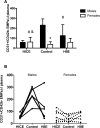Differential impact of acute high-intensity exercise on circulating endothelial microparticles and insulin resistance between overweight/obese males and females
- PMID: 25710559
- PMCID: PMC4339732
- DOI: 10.1371/journal.pone.0115860
Differential impact of acute high-intensity exercise on circulating endothelial microparticles and insulin resistance between overweight/obese males and females
Abstract
Background: An acute bout of exercise can improve endothelial function and insulin sensitivity when measured on the day following exercise. Our aim was to compare acute high-intensity continuous exercise (HICE) to high-intensity interval exercise (HIIE) on circulating endothelial microparticles (EMPs) and insulin sensitivity in overweight/obese men and women.
Methods: Inactive males (BMI = 30 ± 3, 25 ± 6 yr, n = 6) and females (BMI = 28 ± 2, 21 ± 3 yr, n = 7) participated in three experimental trials in a randomized counterbalanced crossover design: 1) No exercise control (Control); 2) HICE (20 min cycling @ just above ventilatory threshold); 3) HIIE (10 X 1-min @ ∼ 90% peak aerobic power). Exercise conditions were matched for external work and diet was controlled post-exercise. Fasting blood samples were obtained ∼ 18 hr after each condition. CD62E(+) and CD31(+)/CD42b- EMPs were assessed by flow cytometry and insulin resistance (IR) was estimated by homeostasis model assessment (HOMA-IR).
Results: There was a significant sex X exercise interaction for CD62E(+) EMPs, CD31(+)/CD42b- EMPs, and HOMA-IR (all P < 0.05). In males, both HICE and HIIE reduced EMPs compared to Control (P ≤ 0.05). In females, HICE increased CD62E(+) EMPs (P < 0.05 vs. Control) whereas CD31(+)/CD42b- EMPs were unaltered by either exercise type. There was a significant increase in HOMA-IR in males but a decrease in females following HIIE compared to Control (P<0.05).
Conclusions: Overweight/obese males and females appear to respond differently to acute bouts of high-intensity exercise. A single session of HICE and HIIE reduced circulating EMPs measured on the morning following exercise in males but in females CD62E(+) EMPs were increased following HICE. Next day HOMA-IR paradoxically increased in males but was reduced in females following HIIE. Future research is needed to investigate mechanisms responsible for potential differential responses between males and females.
Conflict of interest statement
Figures




References
-
- Abbasi F, Brown JBW, Lamendola C, McLaughlin T, Reaven GM (2002) Relationship between obesity, insulin resistance, and coronary heart disease risk. Journal of the American College of Cardiology 40: 937–943. - PubMed
-
- Must A, Spadano J, Coakley EH, Field AE, Colditz G, et al. (1999) THe disease burden associated with overweight and obesity. JAMA 282: 1523–1529. - PubMed
-
- Carroll S, Dudfield M (2004) What is the Relationship Between Exercise and Metabolic Abnormalities? Sports Medicine 34: 371–418. - PubMed
-
- Horowitz JF (2007) Exercise-induced alterations in muscle lipid metabolism improve insulin sensitivity. Exerc Sport Sci Rev 35: 192–196. - PubMed
Publication types
MeSH terms
LinkOut - more resources
Full Text Sources
Other Literature Sources
Medical

